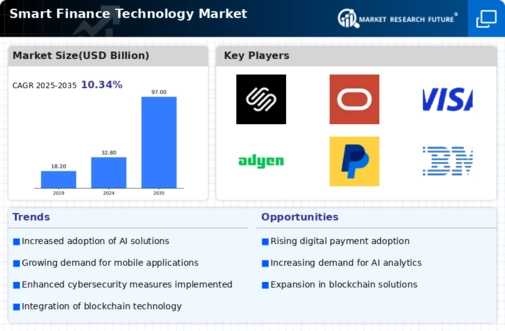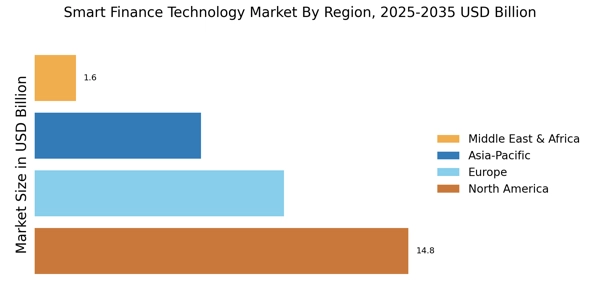Regulatory Support and Compliance
The Smart Finance Technology Market is significantly influenced by evolving regulatory frameworks that support technological advancements in finance. Governments and regulatory bodies are increasingly recognizing the importance of fintech innovations in enhancing market efficiency and consumer protection. For instance, initiatives aimed at fostering competition and innovation, such as open banking regulations, are gaining traction. These regulations encourage traditional financial institutions to collaborate with fintech firms, thereby creating a more dynamic financial ecosystem. Furthermore, compliance with data protection laws and anti-money laundering regulations is becoming paramount, prompting the adoption of advanced technologies. This regulatory support not only mitigates risks but also stimulates investment in the Smart Finance Technology Market, as firms seek to align their operations with compliance requirements.
Rise of Digital Payment Solutions
The Smart Finance Technology Market is experiencing a remarkable rise in digital payment solutions, driven by changing consumer preferences and technological advancements. With the proliferation of smartphones and internet connectivity, consumers are increasingly opting for cashless transactions. Data suggests that the digital payment market is expected to grow exponentially, with mobile wallets and contactless payments gaining popularity. This shift not only enhances convenience for consumers but also reduces operational costs for businesses. Furthermore, the integration of blockchain technology in payment systems is enhancing security and transparency, thereby fostering consumer trust. As a result, the Smart Finance Technology Market is likely to expand significantly, as businesses and consumers alike embrace the benefits of digital payment solutions.
Advancements in Data Analytics and AI
The Smart Finance Technology Market is witnessing transformative advancements in data analytics and artificial intelligence (AI). These technologies enable financial institutions to harness vast amounts of data, leading to improved decision-making and personalized customer experiences. For instance, predictive analytics allows firms to anticipate customer needs and tailor services accordingly, enhancing customer satisfaction. Moreover, AI-driven algorithms are increasingly utilized for fraud detection and risk management, thereby safeguarding financial transactions. The market for AI in finance is projected to reach substantial figures, indicating a robust growth trajectory. As organizations continue to invest in these technologies, the Smart Finance Technology Market is poised for significant evolution, driven by the need for efficiency and enhanced customer engagement.
Growing Interest in Sustainable Finance
The Smart Finance Technology Market is witnessing a growing interest in sustainable finance, reflecting a broader societal shift towards responsible investing. Investors are increasingly seeking opportunities that align with environmental, social, and governance (ESG) criteria. This trend is prompting financial institutions to develop innovative products that cater to socially conscious consumers. Data indicates that sustainable investment assets are on the rise, suggesting a potential market shift. As firms integrate sustainability into their business models, the demand for smart finance technologies that facilitate ESG reporting and impact measurement is likely to increase. Consequently, the Smart Finance Technology Market stands to benefit from this evolving landscape, as stakeholders prioritize sustainability in their financial decisions.
Increased Demand for Financial Inclusion
The Smart Finance Technology Market experiences a notable surge in demand for financial inclusion solutions. As populations in various regions seek access to banking services, technology plays a pivotal role in bridging the gap. According to recent data, approximately 1.7 billion adults remain unbanked, highlighting a significant opportunity for smart finance technologies to provide innovative solutions. Fintech companies are leveraging mobile platforms and digital wallets to cater to underserved communities, thereby enhancing their financial literacy and participation in the economy. This trend not only fosters economic growth but also aligns with regulatory initiatives aimed at promoting financial inclusion. As a result, the Smart Finance Technology Market is likely to witness substantial growth driven by the need for accessible financial services.


















Leave a Comment